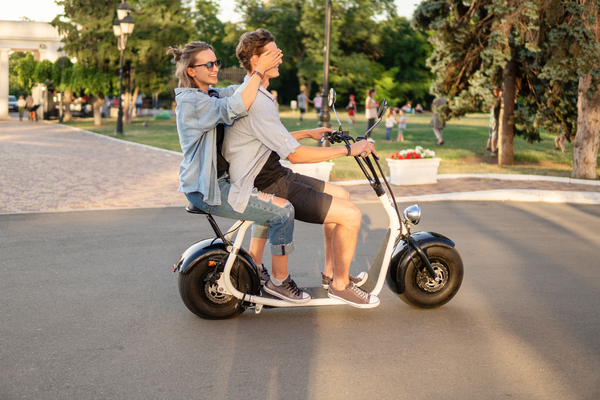Where did electric bikes come from?
The first mention of an electric bicycle appeared at the end of the 19th century in the United States. The first patent for a prototype vehicle of this type was obtained in 1895 (it concerns a “battery bicycle”), and then in 1897 (here we are talking about an electric bicycle driven by a double electric motor).
Riding an electric bike is only possible thanks to the pedal force that activates the entire mechanism, which automatically turns off when the speed exceeds 25 km/h. It is important to note that bicycles driven by an electric motor do not emit exhaust gasses, and the sound produced by the machine is lower than in the case of internal combustion engines.

The presence of a rider, a motor, and a battery distinguishes electric bikes from traditional bikes.
Why are e-bikes so popular now?
It must be understood that now venture investors see e-bikes as the future of urban mobility in many cities, in Spain as well. Electric bikes firstly didn’t get proper recognition in Spain. It was something very heavy, awkward, and scary looking. Many people didn’t understand the need to charge it, if it is enough just to turn the pedals. But then there was a breakdown that began in the Netherlands in the 1960s. More and more cities in Europe, and Spain in particular, in the 2000s began to pay close attention to urban mobility: it became clear that cities are not dimensionless, and all the cars do not fit in them.
Manufacturers of electric bicycles have also competently entered this situation. They understood in which direction to move: not a heavy electric moped with some kind of pedals, but a bicycle with an assistant that helps to accelerate and maintain a certain speed without any effort. And it turns off when the bike accelerates to 25 km / h.
What are the pros and cons of an electric bike?
When using such a bike for daily usage, there is an advantage that a person will come to work not sweaty, neat in appearance, unlike a conventional bike. Moreover, there are such pros:
- Electric bikes are one of the transportation options that can be easily stored in an apartment, especially small ones that are in Spain. There is no smell of gasoline, compared to a motorcycle with an internal combustion engine.
- The small mass of a bicycle, unlike a motorcycle or scooter. This makes it possible to lift it to the upper floors of the house on its own.
- Low cost of charging the battery from the household electrical network.
- During a family bike ride, it will help the elderly as well as children to keep up with the rest of the family.
- E-bikes can be easily transported on public transport, and are foldable options in the trunk of a car.
- If the battery or the electric drive fails on the way, you can easily get to the house using the pedals.
- An electric bicycle is more reliable and simpler than a vehicle powered by a gasoline engine.
There are also disadvantages of this type of transport, but there are not so many of them. The main one is the increased cost of equipment and the price of a bike itself.
Are e-bikes in demand in Spain?
In 2018, more bicycles were bought in Spain than cars. Last year, 780,000 bicycles were sold and 700,000 cars were sold. Car sales fell 30%, while bicycle sales increased 4%.
People in Spain themselves say they plan to create 100,000 cycling jobs by 2025, improve infrastructure and build more bike lanes. Spain is not the first country where bicycles outsell cars, in 2017 Italy recorded the same excess.
A bicycle is a really convenient and useful means of transport. We hope that in Spain in the near future it will be preferable for everyone to buy a bicycle than a car.
What interesting things didn’t you know about e-bikes in Spain?
In one of the cities of Spain, residents will be given funds for the purchase of electric bicycles. The City Council of Santander (Spain) aims to motivate people to switch to more sustainable modes of transport. So, residents will be given 350 euros for the purchase of electric bicycles.
The city council will allocate an allowance totaling 75,000 euros. This is enough to subsidize the purchase of 215 city electric bikes.
Requirements:
- People over the age of 18 can participate in the program;
- It is mandatory to have local registration for at least 6 months;
- E-bikes need to be purchased from a local store, a move to support local entrepreneurs promoting sustainable mobility;
- The price of a bicycle must not exceed 1,500 euros (excluding VAT);
- The vehicle cannot be transferred to a third party within two years.
Is there a future for e-bikes?
At a time when the world came to a standstill due to the coronavirus, confidence in public transport has greatly diminished: passenger flows have declined, and cities have come close to transport collapse due to traffic jams close to critical. Many people realized that riding a bicycle is a better option than standing in traffic jams. In Spain, the interest in bicycles is very visible when you try to buy a bicycle: they are practically out of stock due to high demand. The market simply turned out to be unprepared for the increased demand at times.
A similar situation is happening all over the world. CNBC cites data from bicycle company VanMoof founder Taco Carlier: worldwide demand for this company’s electric bikes has grown by 48% by May compared to the same period last year. This is a significant leap. It is especially visible in the UK, where demand has increased by 184% compared to the spring of 2019.

